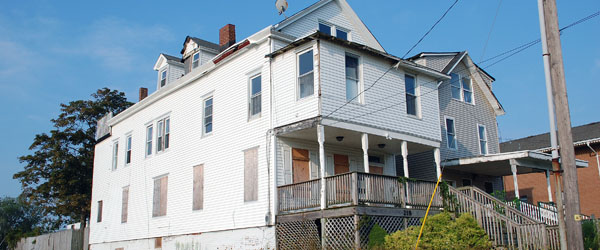City considers ‘spotlight eminent domain’
Process allows towns to take abandoned properties
Asbury Park may soon employ spotlight eminent domain to acquire and demolish dilapidated structures through the state’s abandoned properties law.
Representatives from the Housing and Community Development Network of New Jersey attended Wednesday’s council meeting to tell the governing body how it could use the state’s Abandoned Properties Rehabilitation Act to address properties that previously were “in legal limbo,” said Diane Sterner, executive director of the organization.
Sterner appeared with Alan Mallach, senior fellow at the Center for Community Progress in Washington, D.C. Both have worked with municipalities throughout the state to help them reclaim properties, Sterner said.
To use spotlight eminent domain, towns must first enact an abandoned property ordinance, which establishes an abandoned property list. A public officer is appointed to oversee the vetting of the properties and the creation of the list.
Spotlight eminent domain “takes a shorter length of time to reclaim abandoned properties,” Sterner said. State statute defines an abandoned property as one that has not been legally occupied for six months, and also meets one of four criteria. The four criteria include the building not being in habitable condition; construction that started and was discontinued for six months without the building attaining habitable status; tax delinquency; or a nuisance. The statute defines a nuisance through criteria like vermin, health concerns and crime.
The city must contact the property owner through regular and certified mail, posting notice on the property and publishing its status in the newspaper, Allen said. Owners have the right to prove the city wrong, in which case the home is taken off the list.
“Eminent domain is a sensitive subject but here, we’re talking about a surgical approach for properties that are empty, blighting the neighborhood and not habitable unless someone does something,” Allen said. “No widow or orphan is going to be displaced as a result of this.”
In some cases, the city will be able to take properties without paying owners, Allen said, by calculating “fair market value.”
“You calculate how much it would cost to rehabilitate the property and how much it would be worth at that point,” he said. “If the cost of rehabilitation is more than it would be worth after it’s rehabilitated … there is a rebuttable presumption that the value for taking purposes is zero.”
Oftentimes, property owners will rehabilitate buildings after making the abandoned properties list without further action on the part of the city, Sterner said. This happens 20 to 25 percent of the time, she said.
“I do think this is timely,” Mayor Ed Johnson said. “Yesterday evening, I met with a group of residents on Avenue A and one of their concerns was abandoned property, empty lots or boarded-up properties.”
About 40 municipalities in New Jersey have adopted the abandoned property ordinance so far, Sterner said. Abandoned property lists range from 20 to 600 properties depending on the town.
The abandoned properties program benefits the city because the foreclosure process can often stall when banks are unable to locate property owners, city manager Terence Reidy said. “This program cuts through those barriers,” he added.
Another presentation on abandoned properties legislation will take place at the next council meeting on Sept. 5, Reidy said.












